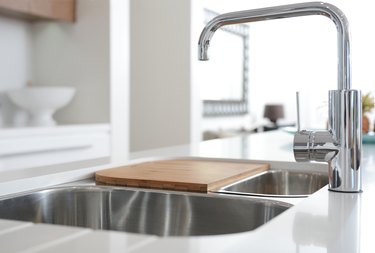
If you have a Glacier Bay faucet, it's probably because you were on a budget when you needed a faucet and went to Home Depot to buy one. Glacier Bay is owned by Home Depot, and its products, which are designed to be basic and affordable, are featured there exclusively, although you can also get them from Amazon. When something goes wrong with a Glacier Bay faucet, there are few extra features to complicate the repair. If you need parts, you can usually get them at Home Depot.
Problems that arise with Glacier Bay faucets are the same ones that occur with other brands, such as flow irregularities and leaks. All Glacier Bay faucets use cartridge valves, and most Glacier Bay kitchen faucet problems can be traced to the cartridge, which is easy to clean and replace. If you have a new kitchen faucet, you might run into problems during installation because the Glacier Bay Fastmount won't tighten and the faucet slips and slides around on the countertop.
Video of the Day
Video of the Day
Glacier Bay Kitchen Faucet With Low Water Pressure
When you install a new Glacier Bay faucet, you should expect normal water pressure. If the flow is less than expected, check the supply hoses for kinks. If you find any, it's probably because the supply hoses, which you have to purchase separately, are too long. Now is a good time to replace them with shorter ones to prevent flow problems in the future.
When you get slow flow from an older faucet, it's usually because mineral deposits have collected on the aerator or are blocking the valve. Unscrew and remove the aerator and try the faucet. If the flow is normal, soak the aerator overnight in white vinegar to clean it. If flow doesn't improve when you remove the aerator, disassemble the faucet, remove the valve and soak it in vinegar. To disassemble the faucet, start by turning off both shutoff valves under the sink, then unscrew the set screw securing the handle using an Allen wrench or Phillips-head screwdriver and remove the handle. Unscrew the collar holding the valve using locking pliers and lift out the valve.
Problems With a Glacier Bay Fastmount Installation
Anyone who has installed a lot of faucets loves the Fastmount connector because you can tighten it by hand. However, when a Glacier Bay Fastmount won't tighten, you can't use a wrench because the connector doesn't have a hex shape. That's not a problem, though; you can simply use locking pliers, but you shouldn't have to.
After slipping the supply hoses through the connector and sliding the connector into position, begin threading it by hand. If you encounter resistance early on, the connector isn't straight, so remove it, readjust it and try again. You're on the right track when it takes little effort to screw the connector onto the faucet post.
When you get to the end and the connector begins to tighten against the underside of the sink deck or countertop, you should be able to tighten it by hand, but if you can't get the faucet to stop moving, you may have to use pliers. Don't overdo it or you could crack the connector. Stop tightening as soon as the faucet is secure and won't move.
Stopping a Leak
Undersink leaks are usually the result of loose hose connections, and these should be tightened with a wrench or pliers. You can't do it by hand. If you have a pull-down model, check the quick connect on the spout hose and reseat it if necessary.
When a Glacier Bay faucet leaks from the spout, the cartridge is probably worn out. Remove the cartridge and take it to Home Depot where you can buy an identical replacement.